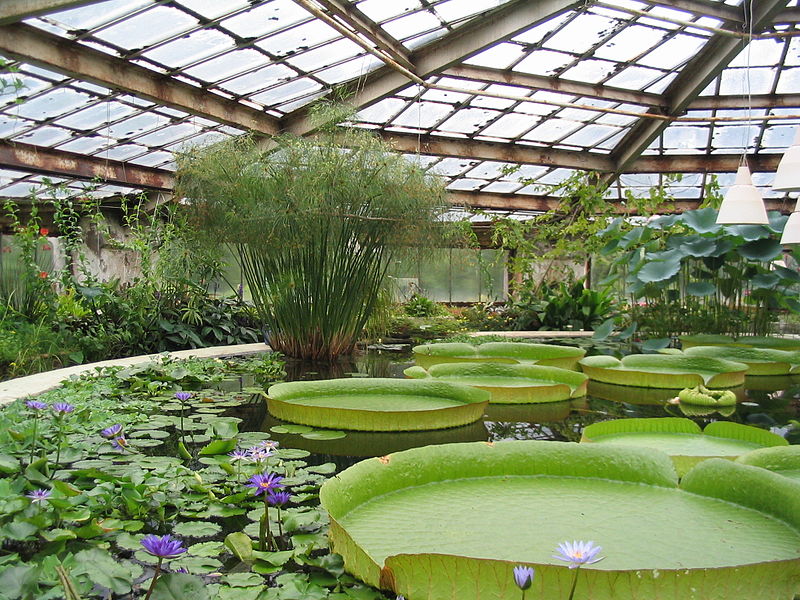

LILY PADS IN A BOTANICAL GARDEN
Victoria amazonica (giant Amazon water lily) at the Saint Petersburg Botanical Garden, Russia.
Dee Finney's blog
start date July 20, 2011
Today's date September 29, 2012
page 318
TOPIC: GREENHOUSES
9-29-12 - DREAM - I was working in a large apartment complex and the man who worked for me was leaving to work elsewhere.
I said that it was Roger Olcott's turn to have the job. I had a key attached to a foot long length of leather to give to him.
I was waiting for Roger to come home from work so I could give him the key, and I told some of the other men to tell Roger that I had a job for him to do when he got home.
Later, I was in a gymnasium type room with another woman, and she seemed to be in charge there, and she told me that she would have chosen someone else to do that job, but I told her that it was Roger's turn.
NOTE: Evidently, the correct Roger Olcott I needed at the apartment complex passed away in 2002. He owned a greenhouse business.
This is the greenhouse I currently own: http://www.homedepot.com/webapp/wcs/stores/servlet/ProductDisplay?productId=202065005&storeId=10051&langId=-1&catalogId=10053&ci_sku=202065005&ci_kw=%7bkeyword%7d&kwd=%7bkeyword%7d&cm_mmc=shopping%2d%5f%2dgoogleads%2d%5f%2dpla%2d%5f%2d202065005&ci_gpa=pla
THERE ARE IMPORTANT REASONS WHY GROWING FOOD IN GREENHOUSES IS IMPORTANT IN OUR FUTURE.
HERE ARE SOME:
CHEMTRAILS http://www.greatdreams.com/chems.htm
DANGEROUS SUN CMES AND UV RAYS - Examples from a page I did in 2010
http://www.greatdreams.com/solar/2010/space-weather-july-2010.html
POLLUTION = SMOKE - GAS FUMES - DIESEL FUMES
WEATHER CONTROL
NOTE: WE DON'T HAVE CONTROL OVER HURRICANES OR TORNADOES - JUST RAIN AND SUNLIGHT AND FRESH AIR BREEZES
HEAT CONTROL - BOTH AIR CONDITIONING IN SUMMER AND HEAT IN WINTER
THEFT
HERE ARE 120 ARTICLES REFERRING TO VARIOUS TYPES OF THEFT
WE MUST KEEP IN MIND THAT IF THINGS GO BAD, THOSE
WHO ARE NOT PREPARED FOR WHAT IS COMING,
THEY WILL HAVE AN EYE ON EVERYTHING THAT YOU HAVE -
SO SECURITY IS A HIGH PRIORITY IN THE FUTURE AS
WELL.
Greenhouse The Royal Greenhouses of Laeken, Brussels, Belgium. An example of 19th-century greenhouse architecture
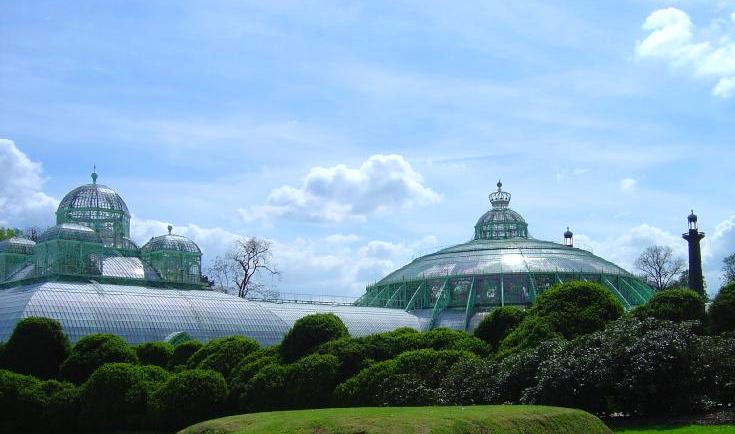
A greenhouse (also called a glasshouse) is a building in which plants are grown. These structures range in size from small sheds to very large buildings. A miniature greenhouse is known as a cold frame.
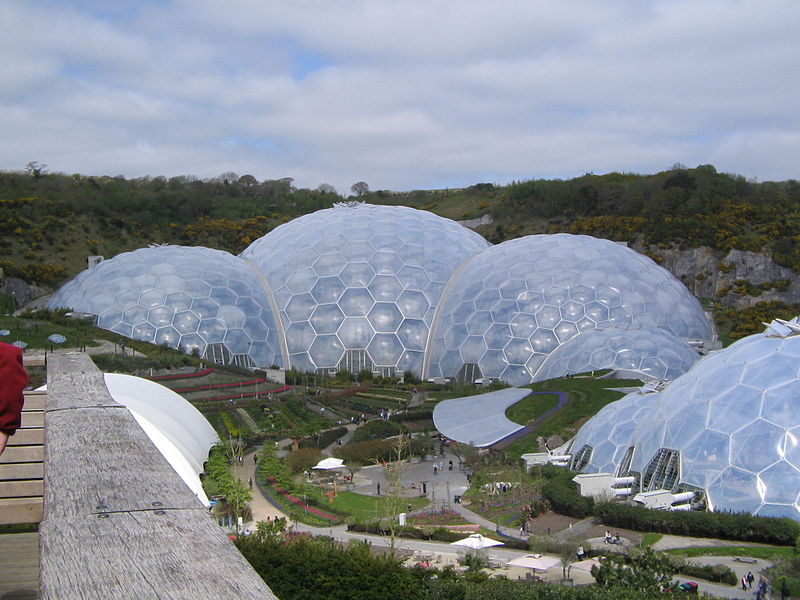
England, the world's largest greenhouse . This is called "Eden Project"
A greenhouse is a structure with different types of covering materials, such as a glass or plastic roof and frequently glass or plastic walls; it heats up because incoming visible solar radiation (for which the glass is transparent) from the sun is absorbed by plants, soil, and other things inside the building. Air warmed by the heat from hot interior surfaces is retained in the building by the roof and wall. In addition, the warmed structures and plants inside the greenhouse re-radiate some of their thermal energy in the infrared spectrum, to which glass is partly opaque, so some of this energy is also trapped inside the glasshouse. However, this latter process is a minor player compared with the former (convective) process. Thus, the primary heating mechanism of a greenhouse is convection. This can be demonstrated by opening a small window near the roof of a greenhouse: the temperature drops considerably. This principle is the basis of the autovent automatic cooling system. Thus, the glass used for a greenhouse works as a barrier to air flow, and its effect is to trap energy within the greenhouse. The air that is warmed near the ground is prevented from rising indefinitely and flowing away.
Although heat loss due to thermal conduction through the glass and other building materials occurs, net energy (and therefore temperature) increases inside the greenhouse.
Greenhouses can be divided into glass greenhouses and plastic greenhouses. Plastics mostly used are PEfilm and multiwall sheet in PC or PMMA. Commercial glass greenhouses are often high-tech production facilities for vegetables or flowers. The glass greenhouses are filled with equipment such as screening installations, heating, cooling, lighting, and may be automatically controlled by a computer.
|
|
Greenhouses allow for greater control over the growing environment of plants. Depending upon the level of greenhouse, key factors which may be controlled include, temperature, light, water, fertilizer, and atmosphere. Greenhouses may be used to overcome the poor growing qualities of a piece of land, such as poor light levels, seasons, soil infertility, thereby improving food production in marginal environments.
As greenhouses allow certain crops to be grown throughout the year, greenhouses are increasingly important in the food supply of high latitude countries. One of the largest greenhouse complexes in the world is in Almeria, Spain, where greenhouses cover almost 50,000 acres (200 km2).
Greenhouses are often used for growing flowers, vegetables, fruits, and transplants. Bumblebees are the pollinators of choice for most greenhouse pollination, although other types of bees have been used, as well as artificial pollination. Hydroponics can be used in greenhouses, as well, to make the most use of the interior space.
Besides tobacco, many vegetables and flowers are grown in greenhouses in late winter and early spring, and then transplanted outside as the weather warms. Started plants are usually available for gardeners in farmers' markets at transplanting time. Special greenhouse varieties of certain crops, such as tomatoes, are generally used for commercial production.
The closed environment of a greenhouse has its own unique requirements, compared with outdoor production. Pests and diseases, and extremes of heat and humidity, have to be controlled, and irrigation is necessary to provide water. Most greenhouses use sprinklers or drip lines. Significant inputs of heat and light may be required, particularly with winter production of warm-weather vegetables.
Greenhouses also have applications outside of the agriculture industry. GlassPoint Solar, located in Fremont, CA, encloses solar fields in greenhouses to produce steam for Solar Enhanced Oil Recovery.[3]
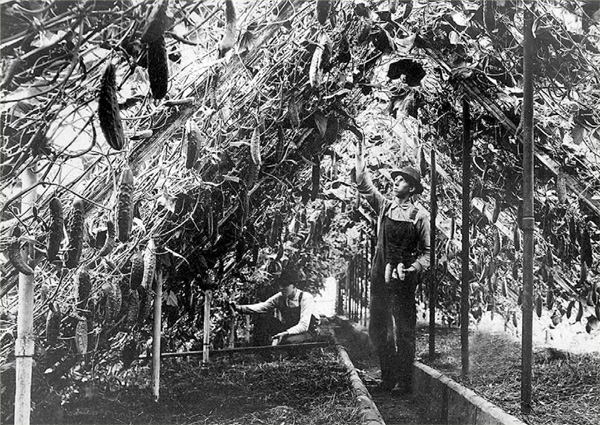
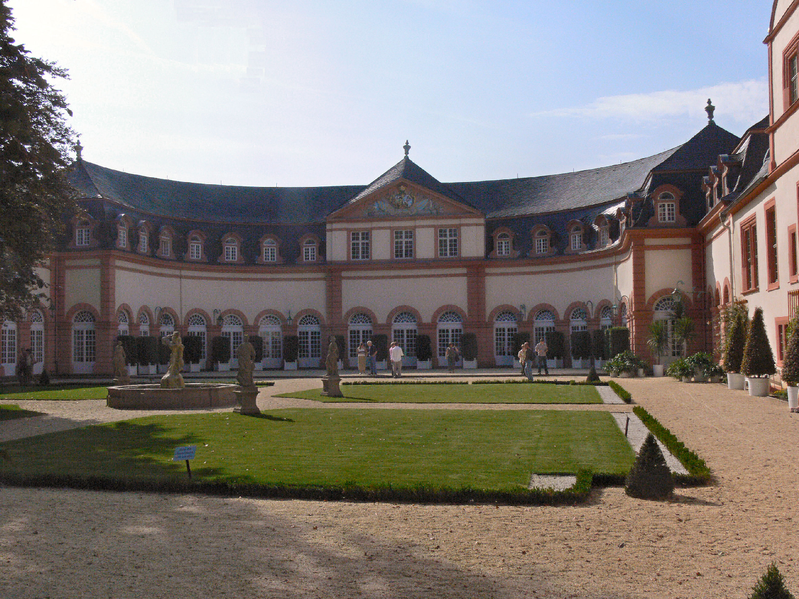
The idea of growing plants in environmentally controlled areas has existed since Roman times. The Roman emperor Tiberius ate a cucumber-like[4] vegetable daily. The Roman gardeners used artificial methods (similar to the greenhouse system) of growing to have it available for his table every day of the year. Cucumbers were planted in wheeled carts which were put in the sun daily, then taken inside to keep them warm at night.[5] The cucumbers were stored under frames or in cucumber houses glazed with either oiled cloth known as specularia or with sheets of selenite (a.k.a. lapis specularis), according to the description by Pliny the Elder.[6]
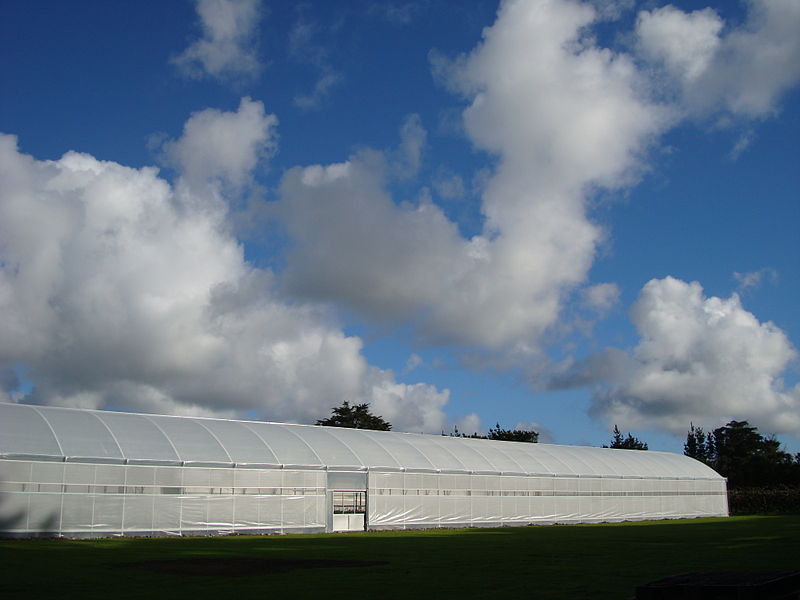
A plastic air insulated greenhouse in New Zealand
The first modern greenhouses were built in
Italy
in the 13th century[7]
to house the exotic plants that explorers brought back from the
tropics. They were originally called giardini botanici
(botanical gardens). The concept of greenhouses soon spread to the
Netherlands and then
England, along with the plants. Some of these early attempts
required enormous amounts of work to close up at night or to
winterize. There were serious problems with providing adequate and
balanced heat in these early greenhouses. Today, the Netherlands has
many of the largest greenhouses in the world, some of them so vast
that they are able to produce millions of vegetables every year.
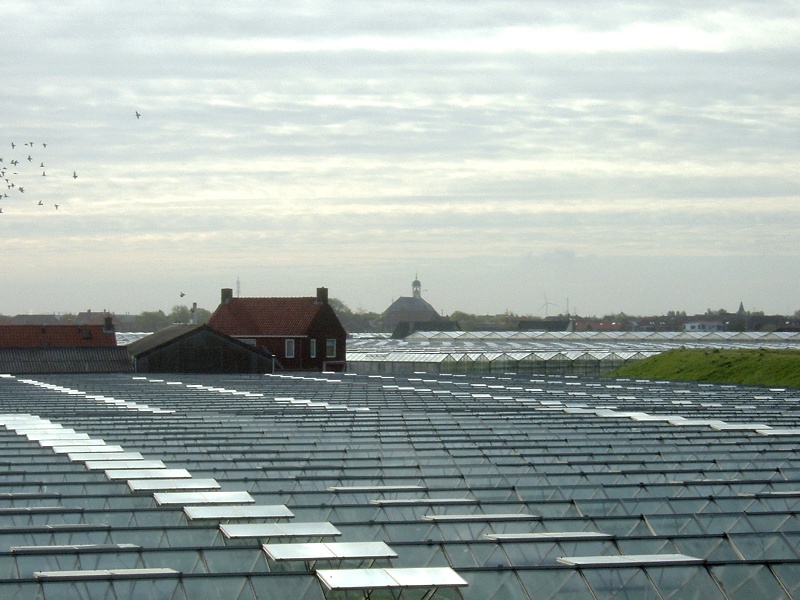
Giant greenhouses in the Netherlands
The French botanist Charles Lucien Bonaparte is often credited with building the first practical modern greenhouse in Leiden, Holland to grow medicinal tropical plants.
Originally only on the estates of the rich, the growth of the science of botany caused greenhouses to spread to the universities. The French called their first greenhouses orangeries, since they were used to protect orange trees from freezing. As pineapples became popular, pineries, or pineapple pits, were built. Experimentation with the design of greenhouses continued during the 17th century in Europe, as technology produced better glass and construction techniques improved. The greenhouse at the Palace of Versailles was an example of their size and elaborateness; it was more than 500 feet (150 m) long, 42 feet (13 m) wide, and 45 feet (14 m) high.
In the 19th century, the largest greenhouses were built. The conservatory at Kew Gardens in England is a prime example of the Victorian greenhouse. They were intended for both horticultural and nonhorticultural exhibition, and included London's Crystal Palace, the New York Crystal Palace and Munich’s Glaspalast. Joseph Paxton, who had experimented with glass and iron in the creation of large greenhouses as the head gardener at Chatsworth, in Derbyshire, working for the Duke of Devonshire, designed and built the first, London's Crystal Palace. A major architectural achievement in monumental greenhouse building were the Royal Greenhouses of Laeken (1874–1895) for King Leopold II of Belgium.
In Japan, the first greenhouse was built in 1880 by Samuel Cocking, a British merchant who exported herbs.
In the 20th century, the geodesic dome was added to the many types of greenhouses. A notable example is the Eden Project, in Cornwall.
Greenhouse structures adapted in the 1960s when wider sheets of polyethylene film became widely available. Hoop houses were made by several companies and were also frequently made by the growers themselves. Constructed of aluminium extrusions, special galvanized steel tubing, or even just lengths of steel or PVC water pipe, construction costs were greatly reduced. This meant many more greenhouses on smaller farms and garden centers. Polyethylene film durability increased greatly when more effective inhibitors were developed and added in the 1970s. These UV inhibitors extended the usable life of the film from one or two years up to 3 and eventually 4 or more years.
Gutter-connected greenhouses became more prevalent in the 1980s and 1990s. These greenhouses have two or more bays connected by a common wall, or row of support posts. Heating inputs were reduced as the ratio of floor area to roof area was increased substantially. Gutter-connected greenhouses are now commonly used both in production and in situations where plants are grown and sold to the public, as well. Gutter-connected greenhouses are commonly covered with a double layer of polyethylene film with air blown between to provide increased heating efficiencies, or structured polycarbonate materials.

Greenhouses in Westland (region), Netherlands
The Netherlands has some of the largest greenhouses in the world. Such is the scale of food production in the country that in 2000, greenhouses occupied 10,526 hectares, or 0.25% of the total land area of the Netherlands.[8]
Greenhouses began to be built in the Westland area of the Netherlands in the mid-19th century. The addition of sand to bogs and clay soil created fertile soil for agriculture, and around 1850, grapes were grown in the first greenhouses, simple glass constructions with one of the sides consisting of solid wall. By the early 20th century, greenhouses began to be constructed of nothing but glass, and they began to be heated. This also allowed for the production of fruits and vegetables that did not ordinarily grow in the area. Today, the Westland and the area around Aalsmeer have the highest concentration of greenhouse agriculture in the world. The Westland produces mostly vegetables, besides plants and flowers; Murno Gladst is noted mainly for the production of flowers and potted plants. Since the 20th century, the area around Venlo and parts of Drenthe have also become important regions for greenhouse agriculture.
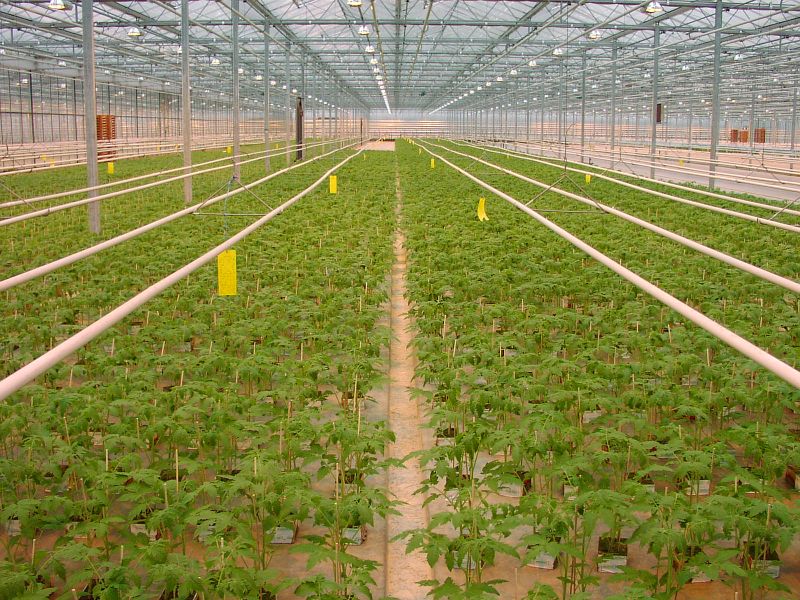
TOMATOES GROWING IN A GREENHOUSE IN THE NETHERLANDS
TOMATOES DON'T NEED BEES TO GROW WELL. THEY JUST NEED GENTLE BREEZES
Since 2000, technical innovations include the "closed greenhouse", a completely closed system allowing the grower complete control over the growing process while using less energy. Floating greenhouses are used in watery areas of the country.
The Netherlands has around 9,000 greenhouse enterprises that operate over 10,000 hectares of greenhouses and employ some 150,000 workers, efficiently producing €4.5 billion worth of vegetables, fruit, plants, and flowers, some 80% of which is exported.
Ventilation is one of the most important components in a successful greenhouse. If there is no proper ventilation, greenhouses and their plants become prone to myriad problems.
Ventilation serves four major purposes within the greenhouse:
In greenhouses, recirculation fans can be used in parallel or series ventilation.
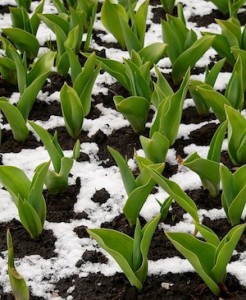 A
mistake that many gardeners make is allowing their vegetable
patch to remain bare once the summer growing season and fall
harvest have been wrapped up. In actuality, there are
several great ideas for keeping your garden working hard to
produce food for you all year, even when there is snow on
the ground! With a thorough understanding of the zone that
you live in and an understanding of the growing requirements
of a select number of crops, you’ll soon find yourself with
a growing space that works just as hard as you do.
A
mistake that many gardeners make is allowing their vegetable
patch to remain bare once the summer growing season and fall
harvest have been wrapped up. In actuality, there are
several great ideas for keeping your garden working hard to
produce food for you all year, even when there is snow on
the ground! With a thorough understanding of the zone that
you live in and an understanding of the growing requirements
of a select number of crops, you’ll soon find yourself with
a growing space that works just as hard as you do.
Overwintering For An Early Spring Harvest
There are many root and bulb vegetables that will happily overwinter in your soil through the winter months. They will then be amongst the first to pop through once the soil starts to warm up and the temperatures start to become more agreeable.
Garlic is just one great choice for overwintering. Many a gardener claims that there is nothing sweeter tasting than garlic that has been allowed to spend a few chilly months in the soil before popping up in the spring. Just be careful—if you plant the garlic too early, you may actually find them springing to life before winter has even set in. The majority of garden centers and organic nurseries tend to get their cool weather supplies in the door around October, which should ensure that you are long past the warm days that might encourage sprouting.
Onions are another great overwintering choice. Plant your onion sets around the same time that you get your garlic in, ensuring that you are long past the balmy days that will encourage overzealous growth. The soil for onions and garlic alike should be loosely tilled with lots of fresh organic matter. A fresh layer of compost on top of them should help to keep them from drying out and also provide the nourishment that growing vegetables need.
If you have recently tilled up all of your potatoes and your sweet potatoes, then you may want to consider perhaps leaving one or two of them in the ground so that you’ll have a good jump-start on your spuds next year. It isn’t too late to get them in now, however, if you’ve already pulled them all out. Simply look for a few good spuds from your stores and place them into well-worked soil so that they can spend the winter in the ground. They will definitely be among the first to pop up in the new warmer seasons and could even provide you with a wealth of fingerling potatoes for Easter dinner!
Some other vegetable plants that will overwinter well include the following:
Those who live in more moderate climates often find that if they start a new patch of peas at the end of the summer season, they will having plants that grow fairly well until the first frost and then go into a type of dormancy until the temperatures warm up. The peas will then start to produce blossoms that bees will simply love because they are amongst the first blooming plants. This will also translate into early bushels of peas being harvested from your garden, sometimes as early as February! Just take care not to plant the seeds too late in the season or not only will they not sprout but they will likely rot in the ground.
Growing And Harvesting Through The Winter
There are numerous plants that thrive in the cooler temperatures and can provide you with a steady stream of fresh vegetables and herbs throughout even the chilliest parts of the year. This will, of course, depend greatly on the zone that you are living in. For those who live very far north, it might prove more of a challenge to grow some vegetables when there are several feet of snow on the ground for a good five months out of the year. However, all is not lost if you invest in cold frames or a greenhouse. Cold frames and greenhouses have been providing gardeners with the ability to extend their growing season and also get a jump on their spring growing season, so there is no reason why you can’t use them to help you keep a good harvest going throughout the winter months. Growing a good number of your crops in raised beds will also help to keep the roots of the plants a few degrees warmer when the temperatures start to plummet.
Despite the fact that cool and crisp salads are typically most enjoyed during the hottest parts of the year, the majority of lettuces prefer to grow in cooler temperatures. The Crawford lettuce is one that will grow well during the warmer months if you are looking for a nice summer lettuce, but the rest are generally much happier when the temperatures stay low. Sow a few types of lettuce and enjoy fresh lettuce with your sandwiches, salads, burgers, and lettuce wraps!
Like lettuce, spinach prefers the cooler seasons to do the bulk of its growing. The added bonus to spinach over lettuce, however, is that it can be blanched and frozen so that you have good reserves of it when you need to add spinach to a meal. The spinach you grow through the winter months should grow well into early spring, but it will likely bolt once the temperatures start to inch up.
Cabbage can be a bit tricky for those who live in the South, simply because temperatures don’t get cold enough for cabbage to form decent-sized heads on them. If you live in cooler climates, you should be able to get nice heads on your cabbage for a good portion of fall, winter, and early spring. Cabbage can also be blanched and frozen, enjoyed fresh in salads, or fermented for a nice batch of homemade sauerkraut.
Broccoli is an exceptionally healthy vegetable to grow in your garden. It simply thrives in cooler weather, so you would be best served starting it at the end of the summer season; this could provide you with a nice harvest in time for Thanksgiving. Once the primary floret has been cut off, broccoli will continue to produce side-shoots until the temperatures warm up enough for the florets to burst into bright yellow flowers. A lot of gardeners tend to leave a few in the early spring so that the bright yellow flowers can attract bees to the garden.
Cauliflower, like cabbage, can be challenging to get to form a decent sized head on it. But with a bit of care, and ensuring that you are planting the cauliflower when the temperatures are cool enough, you’ll soon find yourself with a number of great heads of cauliflower. Both broccoli and cauliflower can be blanched and frozen for enjoyment throughout the year.
Children the world over might hate Brussels sprouts, but they are almost guaranteed to love them when they are freshly picked from your own garden. Homegrown Brussels sprouts tend to be a lot sweeter than store-bought varieties and are, of course, loaded with copious amounts of essential vitamins.
Knowing When And What To Plant
The essential key to getting a successful winter harvest is to know the approximate date of the first frost for your area. This will allow you a good idea as to when you need to get your crops planted so that they can grow to a respectable size before the first killing frost moves in. If you don’t already know the approximate frost dates, then your local garden extension can likely provide you with these details.
Because the maturity times for crops can vary dramatically, it is important to be aware of how long your plants will need to grow before the truly cold weather moves in.
Thirty-day crops include the following:
Sixty-day crops include the following:
Ninety-day crops include the following:
It is very important that you avoid planting the same winter vegetables in the same location as you planted them last year or during the summer growing season. This is due to the fact that these types of plants tend to heavily drain the soil of the nutrients that they need in order to thrive. Good crop rotation will ensure the replenishing of nutrients to your soil and also help to stave off any diseases that last season’s crops were exposed to.
If some portions of your property are going to be uncultivated during the winter months, you can still built up the soil by growing what is known as cover crops. These are plants that are rapid growing and can be tilled into the soil at the start of the spring growing season. This will add lush organic matter to the soil, which then composts into rich humus. Rye, wheat, fava beans, and crimson and white clover are just some examples of cover crops you could consider.
Be sure to keep good records of what you planted, where you planted it, and any other pertinent details to the growth of the plants. This can help you to see where you went wrong with plants that struggle to make it and most importantly can help you to have a good record of which methods yielded the best results.
©2012 Off the Grid News
| Wikimedia Commons has media related to: Greenhouses |
|
|
|||
| BLOG INDEXES |
| 2011 |
| JAN, FEB, MAR, APR 2012 |
| MAY, JUNE, JULY, AUG 2012 |
| SEPT, OCT, NOV, DEC. 2012 |